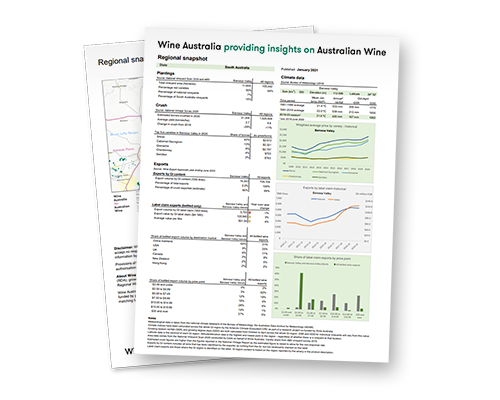The Great Southern wine region is located in the south coast of Western Australia. The regional climate ranges from the coastal, maritime subregions of Albany and Denmark to the inland, continental subregions of Mount Barker, Porongurup and Frankland River.
The GI is 17,131 km2 in size and has a total of 2,545 hectares of vineyards. The main varieties grown in the region are Shiraz, Cabernet Sauvignon, Sauvignon Blanc, and Chardonnay.

Great Southern Regional Snapshot 2023-24
Regional Snapshots are one-page profiles updated annually of individual Australian wine regions. They provide at-a-glance summary statistics on: climatic characteristics, viticulture data, winegrape production, and winegrape price and export sales data for wine, compared against the same statistics for the whole of Australia.
Download nowCabernet Sauvignon
Cabernet Sauvignon thrives across the region, producing long-lived wines of deep colour, intense flavour and powerful structure. They have classic Cabernet sensibilities with an austerity of flavours which reward patience.
Chardonnay
Elegant, tightly structured, grapefruit-accented Chardonnay which ages well is produced in the region. Wines of the south can be a little finer and softer while those of the north are slightly more powerful.
Pinot Noir
Until recently Pinot Noir was regarded as the preserve of the southern area around Denmark and Albany, but some exciting wines have appeared from Mount Barker in slightly cooler years.
Riesling
Riesling vies with Cabernet Sauvignon as the most important wine from the region. The wines age superbly, seldom reaching the peak of their development in less than ten years. As well as being crisp and lean in youth, the wines still have intense flavour, typically in the citrus spectrum with an underlay of herbs.
Shiraz
High quality Shiraz is produced in this region. Great Southern Shiraz exhibits a compelling combination of liquorice, spice, pepper, black cherry and plum. Many producers use well-balanced oak treatment, allowing the fruit quality to fully express itself.

- As one moves north and inland from the strongly maritime-influenced climate of Denmark, the Continental influence and temperature variability increase significantly. Elevation, aspect and sites vary widely, but in general terms the climate of these northern areas is slightly warmer on the higher sites.
- Though rainfall is greater and relative humidity increases in the south around Denmark, heat summation and sunshine hours do not change greatly, so careful site selection allows the production of virtually every wine style.

- The predominant soils are similar to those of the Margaret River region - either lateritic gravelly sandy loams (marri country) or sandy loams deriving directly from granite and gneissic bedrocks.
- They are typically brown to grey-brown in colour, with the percentage of clay varying from one location to another. Fertility is moderate, as are typical yields.
